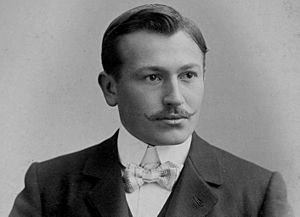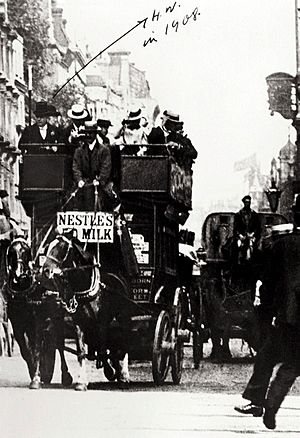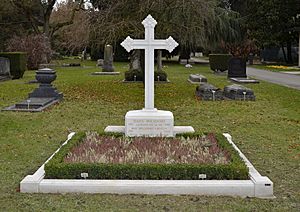Hans Wilsdorf facts for kids
Quick facts for kids
Hans Wilsdorf
|
|
|---|---|

Wilsdorf
|
|
| Born | 22 March 1881 Kulmbach, German Empire
|
| Died | 6 July 1960 (aged 79) Geneva, Switzerland
|
| Citizenship | Bavarian, British (after 1911) |
| Known for | Founding Rolex, the largest single luxury watch brand |
| Spouse(s) | Florence Frances May Crotty (m. 1911–1944). Betty Wilsdorf-Mettler (m. Unknown-1960) |
Hans Wilsdorf (born March 22, 1881 – died July 6, 1960) was a German businessman. He is famous for starting two well-known watch companies: Rolex and Tudor.
Contents
Early Life and Education
Hans Wilsdorf was born in Kulmbach, Germany. He was the second of three children. Sadly, his mother died when he was young. His father passed away when Hans was only twelve years old, making him an orphan.
His uncles took care of Hans and his siblings. They sold the family business and sent the children to good boarding schools. Hans learned to be very independent early in life. He believed this helped him become successful later on.
Hans was very good at math and languages. This made him want to travel and work in other countries. He started his career as an apprentice at a company that exported pearls. This experience taught him many valuable things for his future business dealings.
In 1900, Hans moved to La Chaux-de-Fonds, Switzerland. He began working for a watch company called Messrs. Cuno Korten. His job was to wind hundreds of pocket watches every day. He also made sure they kept accurate time. This job taught him a lot about how watches were made around the world.
Starting Wilsdorf & Davis
In 1903, Hans Wilsdorf moved to London, England. He worked for another watchmaking company there. In 1905, with a small amount of money, Hans started his own business. He partnered with Alfred Davis to create Wilsdorf & Davis. Their goal was to offer high-quality watches at prices people could afford.
Creating the Rolex Brand
In 1908, Hans Wilsdorf came up with the name "Rolex." He said he tried many combinations of letters. One morning, while riding a horse-drawn bus in London, the name "Rolex" came to him. Soon after, the Rolex brand was officially registered in Switzerland.
At the beginning of the 1900s, most people used pocket watches. Wristwatches were not popular. Hans Wilsdorf strongly believed that wristwatches would become popular. He made it his goal to make them well-known.
In 1905, Hans visited Hermann Aegler in Bienne, Switzerland. Aegler made parts for high-quality watch movements. Hans placed a very large order for wristwatch parts. This was the start of a long partnership between Aegler and Rolex. Rolex later bought Aegler's company.
Rolex During World War I
In 1914, World War I started. Hans Wilsdorf changed the name of his company from Wilsdorf & Davis to The Rolex Watch Company Ltd. Just before the war, Rolex made history. On July 14, 1914, a Rolex wristwatch was the first to receive a special Class "A" certificate. This award came from the famous Kew Observatory for its accuracy.
Rolex grew quickly. By 1914, they had over 40 employees. Hans Wilsdorf believed that wristwatches would completely replace pocket watches.
In 1915, the British government added a high tax on imported goods. This caused Rolex to move its main office from London to Bienne, Switzerland. In 1919, Rolex moved its headquarters again to Geneva, Switzerland, where it is still located today.
Major Watch Innovations
The Rolex Oyster (1927)
In 1927, Rolex created and patented the first truly waterproof watch. It was called "The Rolex Oyster." To show how waterproof it was, Rolex gave special aquarium displays to watch dealers. These displays had plants, goldfish, and a working Rolex Oyster watch submerged in water. People were amazed to see a watch still working underwater.
Hans Wilsdorf knew this was a huge step forward in watchmaking. He spent a lot of money on advertising. He chose Mercedes Gleitze, a female swimmer, as his first brand ambassador. She swam the English Channel wearing a Rolex Oyster around her neck.
After Mercedes Gleitze, Hans Wilsdorf chose Sir Malcolm Campbell as another ambassador. Campbell was famous for setting land-speed records.
The Rolex Perpetual (1931)
In 1931, Rolex launched an automatic wristwatch called "The Rolex Perpetual." This watch could wind itself. It used energy from a spinning part inside the watch. This was a big improvement over other automatic watches at the time.
Rolex During World War II
During World War II, many Royal Air Force pilots bought Rolex watches. They preferred them over their standard-issue watches. If these pilots were captured and sent to POW camps, their watches were often taken away.
When Hans Wilsdorf heard about this, he made a special offer. He would replace any confiscated watches for free. Pilots just needed to write to Rolex, explain what happened, and where they were being held. They didn't have to pay until the war ended. Hans Wilsdorf personally managed this effort.
Hans Wilsdorf Foundation
Hans Wilsdorf and his first wife, Florence, did not have children. Florence died in 1944. In 1945, Hans Wilsdorf created the Hans Wilsdorf Foundation. In 1960, he gave his full ownership of Rolex to this foundation. The foundation still owns and controls Rolex today. It uses much of its income to support charities and social causes in Geneva, Switzerland.
More Rolex Innovations
The Rolex Datejust (1945)
In 1945, Rolex introduced another groundbreaking watch: "The Rolex Datejust." This was the first wristwatch to have a small window that automatically showed the date. The Datejust became popular with many famous leaders, including Sir Winston Churchill and U.S. President Dwight D. Eisenhower.
Founding Tudor (1946)
In 1946, Wilsdorf also started a new watch brand called Tudor. Tudor was a part of Rolex. It offered high-quality watches at a more affordable price. Hans Wilsdorf wanted to make a watch that was dependable like a Rolex, but cost less.
The Rolex Submariner (1954)
In 1954, Rolex launched its first special diving watch, "The Rolex Submariner." Rolex worked with the famous French explorer Jacques Cousteau to test early versions of this watch. The Submariner became available to buy after it was shown at the Basel Fair Show in 1954.
The Rolex GMT-Master (1954)
Also in 1954, Rolex introduced another unique "tool watch," the GMT-Master. This watch had all the usual Rolex features, plus a special 24-hour hand. This hand was designed to keep time in a second time zone. It also had a turning bezel with 24-hour markings. The GMT-Master was first made for pilots and people who traveled a lot.
The Rolex Day-Date (1955)
In 1955, Rolex introduced the Day-Date model. This was the first wristwatch to show both the day of the week and the date in separate windows.
The Rolex Milgauss (1956)
The Rolex Milgauss was launched in 1956. This watch was designed to resist magnetism. It was made for scientists who worked in labs or power plants where magnetism could affect watches. The original Milgauss had a second hand shaped like a lightning bolt.
Death and Legacy
Hans Wilsdorf passed away in Geneva, Switzerland, on July 6, 1960. He was buried in Kings Cemetery in Geneva.
Hans Wilsdorf's contributions to the world of watches are very important. The Hans Wilsdorf Foundation still owns and controls Rolex today. Even though Hans Wilsdorf died in 1960, his foundation and Rolex continue to follow his original vision for the company.
See also
 In Spanish: Hans Wilsdorf para niños
In Spanish: Hans Wilsdorf para niños





